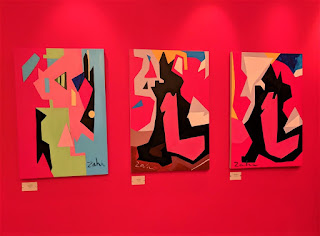Words and images that bring art into the everyday concerns that shape our world. Art is not what you see, but what you make others see.
Tuesday, October 27, 2020
Art Heals: Clutter
Art Heals: Peripety
Art Heals: Wining
Wednesday, August 12, 2020
Art Heals: Plain Vanilla
I spent a lot of time living in Africa and Asia, as well as
in the Middle East. In those days before the internet brought the world’s
products to the door, my choices were constrained by availability.
For most of that time we lived, in the parlance of the international community
“on the economy.” This meant learning to adapt our desires to the local
products we found in the markets and on the shelves of local stores.
Forget brand names and forty different kinds of cereal. We were
just glad that the Blue Nile grocery in Cairo delivered fresh aish to
our apartment.
Today a visit to the local grocery or the Amazon marketplace
reminds me of those take-what-you-can get days. Safeway’s cleaning
products shelves are all but denuded every time I check. Amazon tells me
that disinfecting wipes are not available, and a shipment of plastic gloves
will arrive in October if I order in the next five minutes. Instacart
wants to substitute copier paper for toilet paper. (I draw the line
there.)
Truthfully, I’ve never really cared about having lots of
choices. I’m a creature of habit and don’t love making decisions, so I eat the
same cereal every morning, buy the generic, store-brand whatever whenever I
can. And since childhood, I have always chosen vanilla when we went to 31
Flavors.
Little did I know that was the most exotic choice I could
have made.
I recently learned that vanilla is an orchid!
Having grown up in an environment where orchids were really big pink floppy
things you wore on your wrist on prom night, I was introduced to the beauty and
rarity of orchids by Belgian friends who collected them, and later learned to
love them in Thailand, where they abounded but were no less rare and expensive
for that. Associating those fragile blooms in any way with vanilla never
occurred to me.
For me, vanilla came in little brown bottles at the grocery
and was spooned into cake mixes where I also added an egg to make me feel like
I was actually baking a cake. (Please no comments on my baking skills, or lack
thereof. I already know.)
But of course, that was artificial vanilla. Now I know
that vanilla is a precious, exotic and rare spice. The vine of the vanilla
orchid was cultivated by the Aztecs. Until the mid- 19th
century, Mexico remained the chief producer of vanilla, due to the difficulty
of pollinating the flower. Each flower produces only one fruit pod, achieved
through pollinating the blossom. It seems that the orchid is
hermaphroditic, carrying both male and female organs, separated by a membrane.
A certain kind of bee, living only in Mexico, is able to penetrate the membrane
and pollinate the flower. The vines were transplanted to Europe and
French overseas colonies, but without the bee, which did not thrive outside
Mexico, the vines did not fruit. Enter a brilliant 12-year old boy named
Edmond Albius, a slave on the French island of Réunion. He figured out how to
hand-pollinate the orchid in 1841, using a simple method involving a beveled
sliver of bamboo and his thumb. Unbelievably, this method is still
used today. As the flower lasts just one day, imagine how labor intensive
it is to pollinate and produce the pods containing the tiny black seeds that
are real vanilla.
Ok, so my ongoing case of covid-curvature of the brain has
brought us to this point. Our present lack of multiple choices offers us
the opportunity to examine the choices we can make and appreciate them
in new ways. Something gained from nothing is really something.
Amr Mounib gives us a flower. Not vanilla, but just as
special. Art Heals.


















